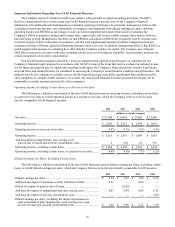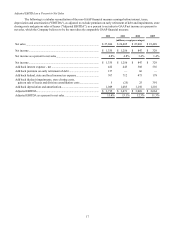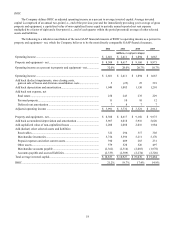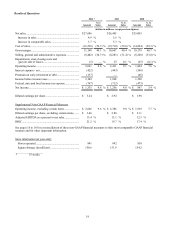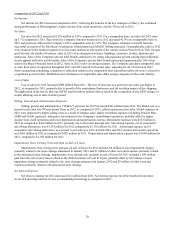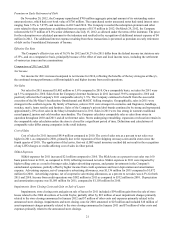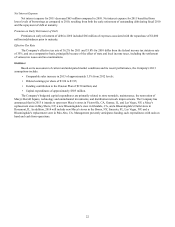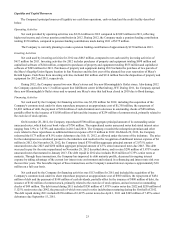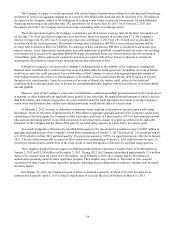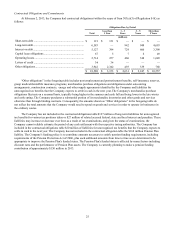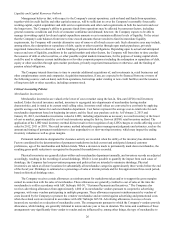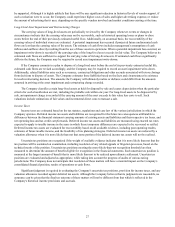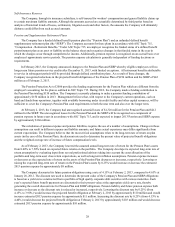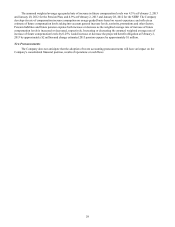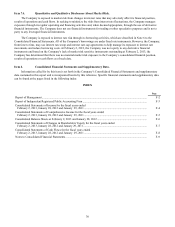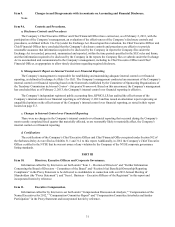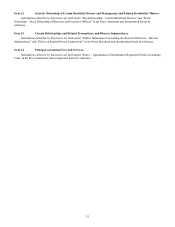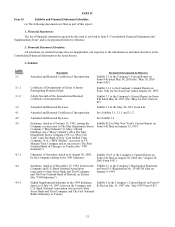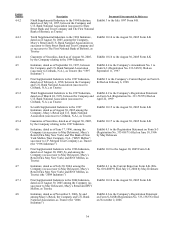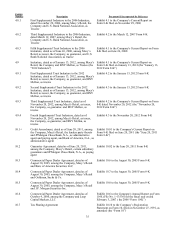Macy's 2012 Annual Report Download - page 31
Download and view the complete annual report
Please find page 31 of the 2012 Macy's annual report below. You can navigate through the pages in the report by either clicking on the pages listed below, or by using the keyword search tool below to find specific information within the annual report.26
Liquidity and Capital Resources Outlook
Management believes that, with respect to the Company's current operations, cash on hand and funds from operations,
together with its credit facility and other capital resources, will be sufficient to cover the Company's reasonably foreseeable
working capital, capital expenditure and debt service requirements and other cash requirements in both the near term and over
the longer term. The Company's ability to generate funds from operations may be affected by numerous factors, including
general economic conditions and levels of consumer confidence and demand; however, the Company expects to be able to
manage its working capital levels and capital expenditure amounts so as to maintain sufficient levels of liquidity. To the extent
that the Company's cash balances from time to time exceed amounts that are needed to fund its immediate liquidity
requirements, the Company will consider alternative uses of some or all of such excess cash. Such alternative uses may include,
among others, the redemption or repurchase of debt, equity or other securities through open market purchases, privately
negotiated transactions or otherwise, and the funding of pension related obligations. Depending upon its actual and anticipated
sources and uses of liquidity, conditions in the capital markets and other factors, the Company will from time to time consider
the issuance of debt or other securities, or other possible capital markets transactions, for the purpose of raising capital which
could be used to refinance current indebtedness or for other corporate purposes including the redemption or repurchase of debt,
equity or other securities through open market purchases, privately negotiated transactions or otherwise, and the funding of
pension related obligations.
The Company intends from time to time to consider additional acquisitions of, and investments in, retail businesses and
other complementary assets and companies. Acquisition transactions, if any, are expected to be financed from one or more of
the following sources: cash on hand, cash from operations, borrowings under existing or new credit facilities and the issuance
of long-term debt or other securities, including common stock.
Critical Accounting Policies
Merchandise Inventories
Merchandise inventories are valued at the lower of cost or market using the last-in, first-out (LIFO) retail inventory
method. Under the retail inventory method, inventory is segregated into departments of merchandise having similar
characteristics, and is stated at its current retail selling value. Inventory retail values are converted to a cost basis by applying
specific average cost factors for each merchandise department. Cost factors represent the average cost-to-retail ratio for each
merchandise department based on beginning inventory and the fiscal year purchase activity. At February 2, 2013 and
January 28, 2012, merchandise inventories valued at LIFO, including adjustments as necessary to record inventory at the lower
of cost or market, approximated the cost of such inventories using the first-in, first-out (FIFO) retail inventory method. The
application of the LIFO retail inventory method did not result in the recognition of any LIFO charges or credits affecting cost of
sales for 2012, 2011 or 2010. The retail inventory method inherently requires management judgments and estimates, such as the
amount and timing of permanent markdowns to clear unproductive or slow-moving inventory, which may impact the ending
inventory valuation as well as gross margins.
Permanent markdowns designated for clearance activity are recorded when the utility of the inventory has diminished.
Factors considered in the determination of permanent markdowns include current and anticipated demand, customer
preferences, age of the merchandise and fashion trends. When a decision is made to permanently mark down merchandise, the
resulting gross profit reduction is recognized in the period the markdown is recorded.
Physical inventories are generally taken within each merchandise department annually, and inventory records are adjusted
accordingly, resulting in the recording of actual shrinkage. While it is not possible to quantify the impact from each cause of
shrinkage, the Company has loss prevention programs and policies that are intended to minimize shrinkage. Physical
inventories are taken at all store locations for substantially all merchandise categories approximately three weeks before the end
of the fiscal year. Shrinkage is estimated as a percentage of sales at interim periods and for this approximate three-week period,
based on historical shrinkage rates.
The Company receives certain allowances as reimbursement for markdowns taken and/or to support the gross margins
earned in connection with the sales of merchandise. These allowances are generally credited to cost of sales at the time the
merchandise is sold in accordance with ASC Subtopic 605-50, “Customer Payments and Incentives.” The Company also
receives advertising allowances from approximately 1,000 of its merchandise vendors pursuant to cooperative advertising
programs, with some vendors participating in multiple programs. These allowances represent reimbursements by vendors of
costs incurred by the Company to promote the vendors' merchandise and are netted against advertising and promotional costs
when the related costs are incurred in accordance with ASC Subtopic 605-50. Advertising allowances in excess of costs
incurred are recorded as a reduction of merchandise costs. The arrangements pursuant to which the Company's vendors provide
allowances, while binding, are generally informal in nature and one year or less in duration. The terms and conditions of these
arrangements vary significantly from vendor to vendor and are influenced by, among other things, the type of merchandise to


